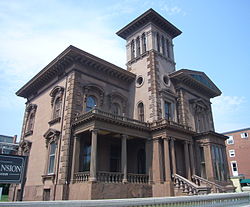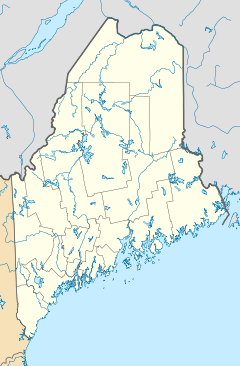- Victoria Mansion
-
Morse-Libby Mansion
 Victoria Mansion
Victoria MansionLocation: 109 Danforth Street, Portland, Maine, USA Coordinates: 43°39′5.4″N 70°15′38.52″W / 43.6515°N 70.2607°WCoordinates: 43°39′5.4″N 70°15′38.52″W / 43.6515°N 70.2607°W Built: 1858-1860 Architect: Henry Austin[1] Architectural style: Italianate Governing body: Victoria Society of Maine NRHP Reference#: 70000074 Significant dates Added to NRHP: December 30, 1970[2] Designated NHL: December 30, 1970[3] Victoria Mansion, also known as the Morse-Libby House or Morse-Libby Mansion, is a landmark example of American residential architecture located in downtown Portland, Maine, United States.[2] The brownstone exterior, elaborate interior design, opulent furnishings and early technological conveniences provide a detailed portrait of lavish living in nineteenth-century America. It was declared a National Historic Landmark in 1971.[3][4]
Contents
House
This stately brownstone Italianate villa was completed in 1860 as a summer home for hotelier Ruggles Sylvester Morse.[1] Morse had left Maine to make his fortune in hotels in New York, Boston and New Orleans.[5] The house was designed by the New Haven architect Henry Austin.[2] Its distinctive asymmetric form includes a four-story tower, overhanging eaves, verandas, and ornate windows. Frescoes and trompe l’oeil wall decorations were created by the artist and decorator Giuseppe Guidicini.
The building is recognized as one of the finest and least-altered examples of a large Italianate Villa-styled brick and brownstone town house in the United States. Gustave Herter created the interiors in a range of styles; this house is his earliest known and only intact commission. More than ninety percent of the original contents survive, including Herter furniture, elaborate wall paintings, artworks, carpets, gas lighting fixtures, stained glass, porcelain, silver, and glassware.[1] The house has twin sinks in the guest bedroom on the second floor, a Turkish smoking room, carved marble fireplaces and a flying staircase.[6] Morse had features incorporated into the house familiar to him from his luxury hotels including the soaring entryway and wall-to-wall carpeting.[5] In its supporting technology, the house was remarkably advanced for the time, with central heating, gas lighting, hot and cold running water, and a servant call system.[1] The water was provided by gutters directing rain water into an enormous tank on the third floor.[5]
Ruggles Morse died in 1893. In 1894, the house and its contents were sold to Joseph Ralph Libby, a Portland merchant.[1] The Libby family occupied the house for over thirty more years, without making significant changes to it.
Museum
The last of the Libbys moved out in 1928. The fate of the house was uncertain and there were plans to demolish it. However, it was saved by William H. Holmes who bought the house in order to preserve it as a museum. In 1941, Holmes opened the house as the Victoria Mansion (named for Britain’s Queen Victoria) as a museum. The Victoria Mansion is committed to the preservation and restoration of the house and its collections.[1]
References
- ^ a b c d e f "Victoria Mansion". Victoria Society of Maine. September 29, 2007. http://victoriamansion.org.
- ^ a b c "National Register of Historic Places". National Park Service. September 29, 2007. http://tps.cr.nps.gov/nhl/detail.cfm?ResourceId=890&ResourceType=Building.
- ^ a b "Morse-Libby Mansion". National Historic Landmark summary listing. National Park Service. http://tps.cr.nps.gov/nhl/detail.cfm?ResourceId=890&ResourceType=Building. Retrieved 2007-10-03.
- ^ Charles W. Snell (July 29, 1970). National Register of Historic Places Inventory-Nomination: Victoria Mansion / Morse-Libby HousePDF (375 KB). National Park Service, and Accompanying 3 photos, exterior, from 1970PDF (906 KB)
- ^ a b c Stephen May (July 13, 1997). "The Height of Victorian Panache". New York Times. http://query.nytimes.com/gst/fullpage.html?sec=travel&res=9F00E7D81530F930A25754C0A961958260.
- ^ Jane Holtz Kay (May 13, 1990). "A Rough-Hewn Maine Seaport". New York Times. http://query.nytimes.com/gst/fullpage.html?res=9D0CE6DD1E38F930A25756C0A966958260&sec=travel&spon=&pagewanted=print.
External links
- Official Site
- Morse-Libby Mansion, Library of Congress
- Morse-Libby Mansion, National Historic Landmarks Program, National Park Service
- Morse-Libby Mansion, National Register Information Service[dead link]
U.S. National Register of Historic Places Topics Lists by states Alabama • Alaska • Arizona • Arkansas • California • Colorado • Connecticut • Delaware • Florida • Georgia • Hawaii • Idaho • Illinois • Indiana • Iowa • Kansas • Kentucky • Louisiana • Maine • Maryland • Massachusetts • Michigan • Minnesota • Mississippi • Missouri • Montana • Nebraska • Nevada • New Hampshire • New Jersey • New Mexico • New York • North Carolina • North Dakota • Ohio • Oklahoma • Oregon • Pennsylvania • Rhode Island • South Carolina • South Dakota • Tennessee • Texas • Utah • Vermont • Virginia • Washington • West Virginia • Wisconsin • WyomingLists by territories Lists by associated states Other Categories:- NRHP articles with dead external links
- Houses completed in 1860
- National Historic Landmarks in Maine
- Historic house museums in Maine
- Museums in Portland, Maine
- Houses in Portland, Maine
Wikimedia Foundation. 2010.

